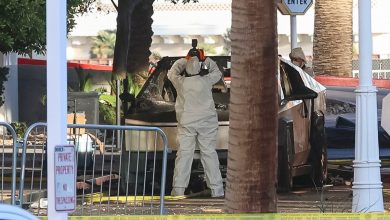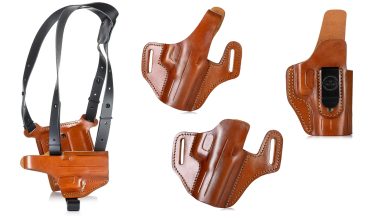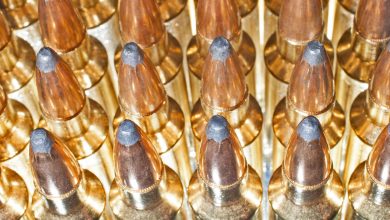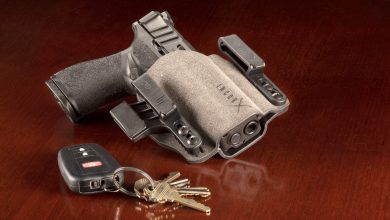Review: Walther PPK/S in .32 ACP
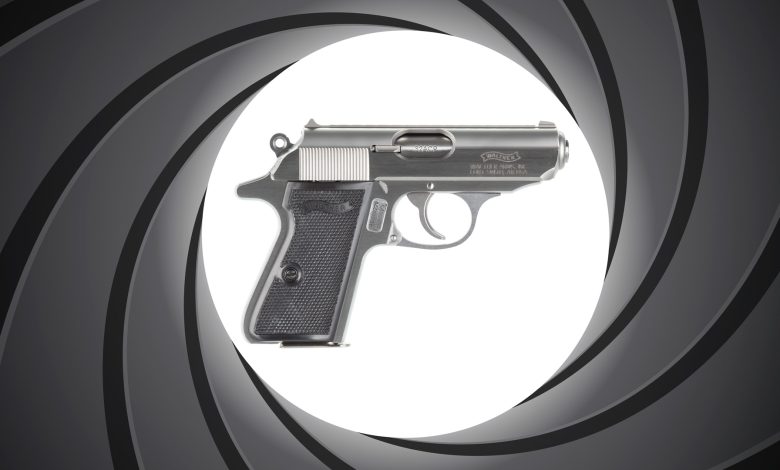
“…with a delivery like a brick through a plate-glass window.” I’m sorry; I hate to shatter illusions, but with the exception of that line, author Ian Fleming was a horrible writer. Before equipping his hero with a .32 ACP in “Dr. No,” he had Bond packing a .25 ACP. Really? However, when he did upgrade him (at the advice of firearms expert Geoffrey Boothroyd), Fleming elevated Bond’s armament to a superb choice: the Walther PPK. The original PP was a full-size pocket pistol (if that isn’t an oxymoron, it should be). To accommodate the detectives in German police forces Walther shortened the PP in both directions to make the PPK.
Well, sometimes less is more and sometimes less is less. The PPK/s is the frame of the PP with the slide and barrel of the PPK, offering a good handful to hold, but a short barrel to help conceal and provide some carry comfort. What is different about the PPK/s now is that Walther has brought it back in .32 ACP.
It and the .380 ACP cartridges were both designed by John Moses Browning (the .32 in 1900, the .380 in 1908), and when it came time to settle on the smallest-suitable defensive cartridge in a pistol, we Americans snubbed the .32 ACP for the .380 ACP. So much so, that the only Walthers I recall seeing—PP, PPK, PPK/s—were all chambered in .380 ACP, save for one. That was the ultra-rare PPK/L; one of which I scored and now belongs to my brother.
Well, now the .32 is back, and you can have one like Bond’s, only better.
The topstrap is grooved to break up reflected glare • Though small, both the rear and front sight are enhanced by a touch of eye-catching red • Walther’s banner logo graces the front of the slide • The perfectly ovoid shape of the port adds to the PPK/s’ lines • Hard black polymer panels provide both an authentic look and adequate purchase.
The Walther PP family got started back in 1929. Developed primarily as a police sidearm, it was the height of modernity. The blowback action was made with a firing system that had all the advantages you could want. First, it used what would later be called a traditional double-action trigger system. The first shot can be fired with a long trigger pull, one that cocks and then releases the hammer, just like a double-action revolver. But, the slide’s movement in cycling cocks the hammer for subsequent shots, unlike a revolver. Rather than leave the hammer cocked, the safety, mounted on the slide, blocks the firing pin and then drops the hammer to the un-cocked position. While today we view that as old hat in the era of striker-fired pistols, in 1929 it was as high-tech as an all-metal aircraft with one wing and not two.
As if that weren’t enough, the slide also had a loaded-chamber indicator. That was (and is) a small rod in the slide above the firing-pin channel. When there is a round in the chamber, the rod is pressed back by the cartridge rim and the rod protrudes from the back of the slide. A quick swipe with a fingertip tells you whether there’s a round in the chamber.
The PP later evolved into variants chambered in .22 LR, .25 ACP and the short-lived 9×18 Ultra. For those needing a more compact version of an already flat and compact pistol, Walther made the PPK. This shortened both the slide and frame of the PP, and changed the grips from flat plastic (Bakelite, from pre-war times) to wrap-arounds. The one we are all familiar with, the PPK/s, came about for bureaucratic reasons. With the passage of the Gun Control Act of 1968, the government instituted an import-points system. If a pistol fails to score enough points, it can’t be imported. The PPK fell short, but by combining the slide of the PPK with the frame of the PP, the new PPK/s (“S” for sport, as a legal fig leaf I surmise) scored just enough points to clear the import hurdle, and thus was allowed into the country.
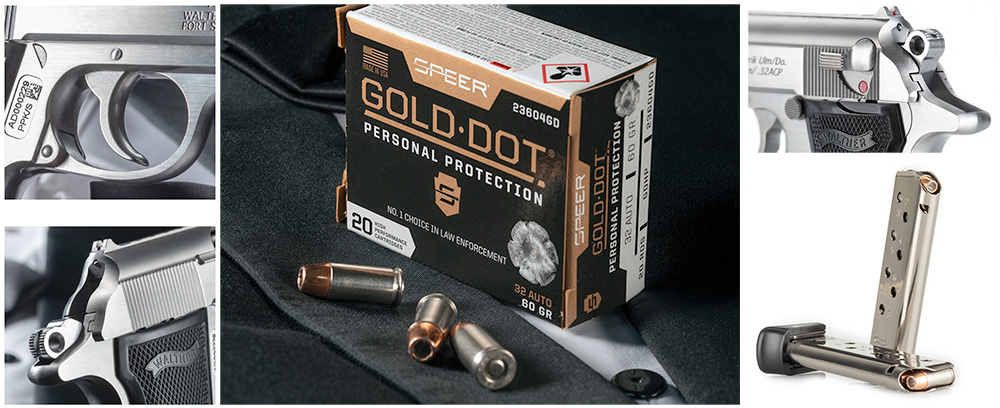
The pistol’s heavy DA trigger pull provides a considerable margin of safety • When cocked, the hammer rests in a recess in the abbreviated beavertail • The safety lever is also a decocker, allowing the hammer to be safely lowered with a round in the chamber • Modern jacketed hollowpoints have greatly improved the .32 ACP cartridge • Highly polished, the two magazines are first-rate.
We Americans snapped them up whenever we had the chance. Working in gun shops on the border of a very dangerous city (both then and now), it was common to have law enforcement customers who carried backup pistols. Those who used revolvers used one or another hammerless model, but those packing semi-autos invariably sported a Walther of one type or another. If they bought one new (instead of using a surplus bring-back), they bought them in .380—for good reason. The Walther was obviously well-made, invariably ultra-reliable, and flat as a pancake. I noted more than one officer who carried his (or her) backup Walther in a holster that fit on the inside of their duty belt, right behind the spare magazine pouches for their duty 9 mm pistol.
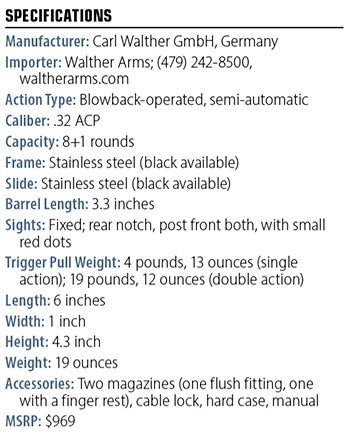 And, all were chambered in the better regarded .380 ACP, because no self-respecting big-city copper was going to pack a .32. Well, some did, because back then the only ammo to be had was FMJ, and when you are using FMJs, the difference in effect was thought to be minor. Plus, the .32 held a round more than did the .380.
And, all were chambered in the better regarded .380 ACP, because no self-respecting big-city copper was going to pack a .32. Well, some did, because back then the only ammo to be had was FMJ, and when you are using FMJs, the difference in effect was thought to be minor. Plus, the .32 held a round more than did the .380.
Well, times are different. For one, today Walther makes the PPK/s (and the PPK as well) with a stainless finish. The shape of the tang was also changed some years ago to provide better protection to your hand when shooting. Designed back in the 1920s, when one-handed shooting was the norm, the original tang didn’t offer enough protection to modern shooters who grip the frame higher and tighter than shooters did back then. My hand in particular is at risk of the two-track slide slice when shooting the older Walthers if I’m not careful. The new tang is much more forgiving than the old.
The safety stays down when you use it. It is not spring-loaded, so you have to decide when you are going to carry the PPK/s (or use it as a home-defense tool): safety up or safety down? Safety up means once you have safely dropped the hammer you press the lever back to horizontal, and you will then simply have to press the trigger to fire. Down means when you apply the safety and drop the hammer, you leave the lever right there. When you draw or pick up the Walther, you must re- member (or have built the reflex) to rotate the safety up to horizontal, usually with your right thumb. Leaving the lever down is thought by some to be safer, since it adds steps should someone unauthorized pick it up or were it to be wrestled away from you.
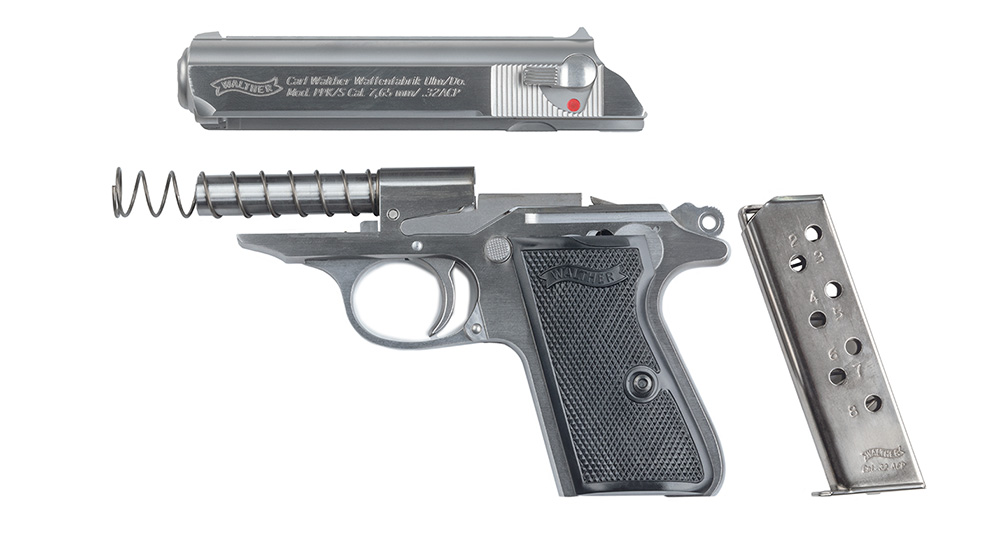
Fabricated from stainless steel and easily taken down into its constituent component groups, the PPK/s is not difficult to maintain. All you need is a brush, some patches, a cloth and some CLP, and you’re good to go.
The PPK/s comes in a neat, molded and textured case that has a pair of luggage-style latches on it. Compact and nicely proportioned, if it didn’t have the Walther banner on it, you’d think it was a tactical jewelry or cosmetics case. There’s a spare magazine along with the PPK/s, and the case comes in a white-gloss fiberboard box, again a bit of almost-jewelry presentation.
In testing, there were no failures, which was as expected. In fact, had there been any, I likely would have brushed up on my German and phoned Walther in Ulm and asked someone what was going on? As an all-steel pistol chambered in .32 ACP, you’d expect there to be little or no recoil. There is some, and it is a bit snappy, simply because the PPK/s is a blowback system, but it isn’t anything out of the ordinary. In fact, the frame and grip shape are such that the recoil becomes just part of the noise and cycling of the pistol.
Looking at the chart, you might think the accuracy was just OK. Again, this isn’t a target pistol. The sights are small with a sight radius of only 4.38 inches, and the trigger, because it is a traditional-double-action, has overtravel in single-action. The DA trigger pull was higher than my Lyman gauge could measure, and the single-action was just shy of 5 pounds. Plus, .32 ACP ammunition is not made to target specifications. If you are expecting NRA Precision Pistol-level accuracy (or to be able to use it if it were present) you’d be disappointed. Still, the .32 ACP shot more accurately than .380 ACP PPK/s I have tested in the past.
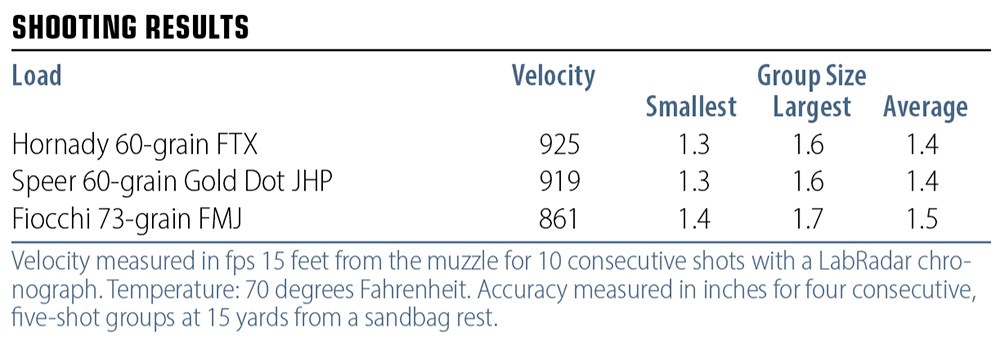
The ammunition choices for .32 ACP are much greater than they were back when I was outfitting local police with their personal armament. Back then, it was FMJ or nothing. Now, you’ve got choices. Hornady offers both its XTP and FTX in a 60-grain bullet. (The traditional FMJ is 71 grains.) Speer just announced and is offering a 60-grain Gold Dot as well as an aluminum-cased 71-grain FMJ. The latter would be a great practice load, as it would be less expensive than others. PMC Bronze lists a 60-grain JHP, although I was unable to score any for testing. And every ammunition manufacturer who offers something in .32 ACP offers a 71-grain FMJ. (Or, in the cases of Fiocchi and Sellier & Bellot, 73 grains) If you buy in bulk, you can get the price of the FMJ offerings at less than 50 cents per round, a deal in these times.
As a hard-hitting defensive pistol or an everyday carry (EDC) pistol, some might feel that the PPK/s falls short. After all, .32 ACP isn’t a sledgehammer. Nine rounds (eight in the magazine and one in the chamber) for carry isn’t a lot compared to the slew of comparably sized 10-, 11- and 12-plus-round 9 mms to be had. And, if you are accustomed to a striker-fired pistol, a double-action will take some getting used to.
But, as a backup—a backup with class—the PPK/s is superb. The only thing flatter is a CD (kids, ask your parents). And for someone with small hands, or who is sensitive to recoil, the frame and grips are easy to manage, and the recoil is not off-putting. On top of all that, if anyone asks, the answer is: “It’s the pistol Bond carries, only better; it is stainless steel.”

Read the full article here


